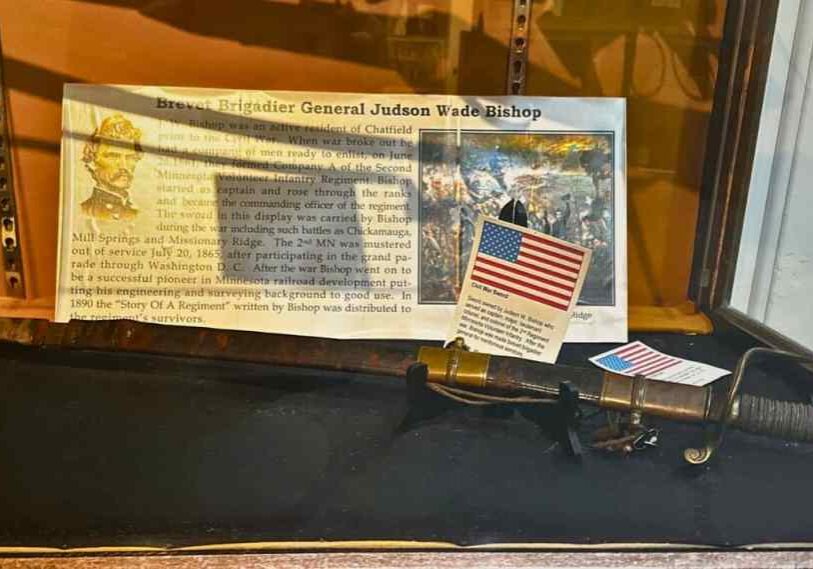Chert Quarry Near Grand Meadow Was Historic Social Center
Archaeologists’ “lucky find” was once a crossroads for Indigenous people

GRAND MEADOW — Researchers have confirmed that a 200-acre area in eastern Mower County was not only an important source of chert for Indigenous people, but also a historic crossroads for Native Americans living in or near what is now Southeast Minnesota.
An eight-acre parcel northwest of Grand Meadow, known today as the Grand Meadow Chert Quarry/Wanhi Yukan Archaeological and Cultural Preserve, opened to the public for the first time in July. Visitors can learn from the interpretive signs installed at the site and see remnants of the quarry that for centuries provided chert, a kind of stone with unique properties for making tools and weapons.
In this second of a two-part story (read part one here), Tom Trow, Grand Meadow Chert Quarry lead archaeologist and project coordinator, guides us through the most recent years of research and the history discovered along the way.
Something unusual in the fields
Trow has been aware of the site since 1980 when he served as field director for an archaeological survey working in southeastern Minnesota.
He learned at the time that a local collector and amateur archaeologist, Maynard Green, had called attention to the site nearly 30 years earlier, but researching the site never gained traction — until Trow and an associate, Lee Radzak, went to check it out in 1980.
As Trow explained, “There was a carpet of broken chert. You could see thousands of pieces scattered out there of broken chert left over from making tools, so we knew right away there had been something going on here.”
“This is actually bedrock chert just sitting there, which you have to dig a little bit to get out, almost unheard of because usually it is so deep and buried you can’t get at it.”
Trow recalled that “Maynard did an interview in the 1990s on TV that I’ve seen a clip of, and they asked him about that moment when he brought us in and showed us. He said, ‘them boys, purty near lost their minds,’ which I never denied.
“In fact, we were stunned by the whole site. It’s just an amazing place. It feels as though everything is a hole in the ground, and then it’s a backfill pile, and then another hole in the ground. There’s nothing flat anywhere.”

This is a 3D view of the quarry underneath the vegetative cover using LIDAR, or Light Detection and Ranging, a remote sensing technology that uses light in the form of a pulsed laser to measure distances to the Earth.
Trow changed jobs shortly after that, going to work at the University of Minnesota (UMN), so the land just sat there until he got back and started working on the project about four years ago.
The site was, however, added to the National Register of Historic Places in 1994; it was later purchased and put into permanent protection by the Archaeological Conservancy.
While he was at the UMN, Trow was able to determine the quarry was far larger than the preserve when he looked at a 1968 flyover map, an aerial view, of the quarry area he found in the map library at the University. The photo was taken at an opportune time because a neighboring farmer had just cut down the trees on the pitted land, but he had yet to convert it to farmland before the airplane came by.
The photo showed numerous exposed pits, information which prompted Trow to try to measure the approximate area of the entire quarry, coming up with close to 200 acres.
More than a quarry
Originally, archaeologists were thinking the Grand Meadow site was only used as a chert procurement site to get stone. However, as they learned more, they realized it was much more than a quarry.
“Our new perspective on why the Grand Meadow chert quarry is important isn’t just the stories I have been telling you about the rock, it’s also the fact that this was a major place for people to come together and meet,” said Trow.
At the time the quarry was being used, there was a ring of villages all within 70 to 100 miles away that surrounded the quarry. They include the Red Wing, Blue Earth, La Crosse and Upper Iowa villages.
These villages all have evidence of Grand Meadow chert showing up in large quantities as small scrapers or projectile points. For example, 97 percent of hide scrapers found at a Red Wing village were made of Grand Meadow chert.

This is a portion of a large painting by Art Kenyon of Red Wing that shows the chert quarry as it might have appeared around the year 1100, or 900 years ago.
Archaeologists speculate that people gathered to work at the quarries in the spring and fall before big hunts, staying at the quarry for several days.
“We were missing a key element to this story, which is, this is seasonal,” Trow said. “Chances are they (people from different villages) would have run into each other, in the beginning by accident, but from then on they would do it on purpose.”
He thought the gatherings were festive occasions where people from the different villages shared stories, knowledge, recipes, farming strategies and ceramic styles.
The quarry started about the same time as “there was a massive change in all of this cultural stuff going on,” said Trow, a span during the Mississippian Period when agriculture emerged.
At the same time, near where St. Louis is today, there was a city called Cahokia growing to more than 20,000 Indigenous people — it was the biggest city in North America and even bigger than London at that time. Cahokia had a large earthen mound that was bigger than the Pyramid of Giza, or Great Pyramid, a central plaza and evidence of a complex society that extended its reach far across what is now the United States.
Development takes on look of park
When Trow came back to work on the project in 2001, there was a lot of buckthorn, even huge buckthorn trees, that made it nearly impossible to explore. Volunteers helped clear some of the invasive species so trail development could start and, eventually, a grant from the Minnesota Department of Natural Resources provided funds to hire a firm to eliminate it for good.

Tom Trow, the project director and lead archaeologist of the Grand Meadow Chert Quarry/Wanhi Yukan Archaeological and Cultural Preserve, surveys the site from the trail that weaves through the site. (Photo by Karen E. Cooper)
“Ultimately what we are trying to do is convert it into the oak savannah that probably once was,” said Trow. “An oak savannah is a combination prairie understory with oak trees and only oak trees because they survive fire and the prairie requires fire.”
The site has a three-quarter-mile trail, much of it handicapped-accessible, with 12 interpretive signs in Dakota and English. About three-quarters of the way along the trail, a talking circle with one-ton stone benches is situated in sight of a 500-year-old oak called the grandfather tree.
A parking area for cars and bikes is located along the adjacent county road. A grassy area not open to the public will be available to native partners for youth development.
“My home run is having a kid come here whose ancestors dug one of these pits and just feels proud,” said Trow. “So that’s what I’m aiming for there.”
The site will be open to the public annually June through October for self-guided walking tours from dawn to dusk. A dozen of the nearly 100 pristine pits will be kept clear of vegetation for easy viewing.

The preserve is set up somewhat like a park, although there is no picnic area. The site also includes five acres of restored prairie adjacent to the quarry area.
Collaborative process to the end
When Trow started the project, the first people he talked to were members of the Prairie Island community. The additional name in the title, Wanhi Yukan, which translates to “there is chert here,” was contributed by a Mdewakanton elder who chose the name because it’s a Dakota tradition to name places after the resource that is present.
Trow said the title also emphasizes that the land isn’t just an archaeological site, but also a cultural preserve.
“We added the word cultural on purpose,” he said. “It is meant to be a project that’s attractive to members of the descendant communities, the people whose ancestors created this site. And in that sense, it’s not just an archaeological or historic place.
“It’s a living, breathing place as part of their culture and their lives. And we wanted to make sure that they understood that we understood that as we worked.
“The day we first had people come to visit, it was two tribal communities . . . and even before we started, two elders went in while the rest of us all stayed outside, and they burned sage, a smell that had not been there for 600 years, and they sang a song of gratitude to the earth, for its gifts, and that had not been heard in there, but it was probably heard every day when this quarry was active.”
The Mower County Historical Society, which helps manage the site, has also been a key contributor.
Trow noted that Green’s collection is at the museum on the fairgrounds in Austin. The display at the museum is “extremely well presented and a story well told,” probably the best exhibit there is in southeastern Minnesota about the pre-contact periods, noted Trow. He added that Green’s friend, Mearl Raygor, who also collected artifacts, has some on display at the Spring Valley museum.
Over the past few years, Trow has found numerous entities that have helped make the preserve a reality. He said he has been amazed at all the varied groups that have contributed, compiling a lengthy list of them.
There has also been a lot of interest in the project even before it was completed. A lecture by Trow at the Chatfield Center for the Arts in April drew a crowd of people. He has also given a virtual lecture through the Archaeological Conservancy, watch it here:
Trow, who has also been an executive in charge of documentary productions at Twin Cities Public Television, is seeking funding for a 30-minute documentary to be produced in 2026 with the local PBS station in Austin.
“It’s been an extraordinary experience for me,” said Trow. “Finding a preserved site like this that has been untouched is extraordinarily lucky and rare.”
Check out the latest, including when/where to visit, on the Mower County Historical Society’s website.
Related to this story is how researchers are uncovering links between historic trails once used by Native Americans and recreationalists who today are using the same trails. To learn more, read Root River Current’s Shooting Star Trail was Once an Indigenous Crossroads.
Also of interest: MPR’s Southern Minnesota quarry site reveals history of Indigenous toolmaking.






